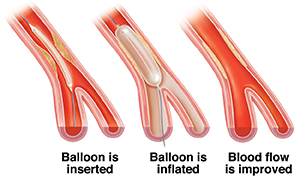Peripheral Angioplasty
Peripheral Angioplasty

Peripheral angioplasty is a procedure that helps open blockages in peripheral arteries. These vessels carry blood to your lower body, legs, and arms.
Talk with your healthcare provider about the risks and complications of angioplasty.
Before the procedure
Recommendations of what to do include:
-
Tell your healthcare provider about all medicines you take including over-the-counter medicines, herbal supplements, and any allergies you may have, especially to iodine.
-
Follow any directions you’re given for not eating or drinking before the procedure.
-
Arrange for a family member or friend to drive you home.
During the procedure
-
You may get medicine through an IV (intravenous) line to relax you. An injection will numb the site your healthcare provider will use to perform the procedure. The site used is generally an artery in the groin although the wrist or arm may be used. The healthcare provider makes a tiny skin cut (incision) near an artery in your groin.
-
Your healthcare provider puts a thin, flexible tube (catheter) through the incision. He or she then threads the catheter into the affected artery while using X-ray monitoring.
-
Contrast “dye” is injected into the catheter. X-rays (angiography) are taken.
-
A tiny balloon is pushed through the catheter to the blockage. Your healthcare provider inflates and deflates the balloon a few times. This compresses the plaque. A small metal or mesh tube (stent) may be put in the artery to help keep it open. The balloon and catheter are then taken out.
After the procedure
You’ll be taken to a recovery area. Pressure is put on the insertion site for about 30 to 45 minutes. Your healthcare provider will tell you how long to lie down and keep the insertion site still. You will go home that day or spend the night in the facility. You will be given aftercare instructions for when you go home.
Call your healthcare provider
Call your healthcare provider right away or get immediate medical attention if:
-
You notice a lump or bleeding at the site where the catheter was inserted
-
You feel increasing pain at the insertion site
-
You become lightheaded or dizzy
-
You have leg pain or numbness
-
You have a leg that turns blue or feels cold
-
You develop a fever greater than 101.5°F (38.6°C).
-
You develop a skin rash
-
You cannot urinate after the procedure
-
You have chest pain or shortness of breath
Updated:
March 16, 2019
Sources:
Angioplasty and Stenting. The Society for Vascular Surgery
Reviewed By:
Deepak Sudheendra MD